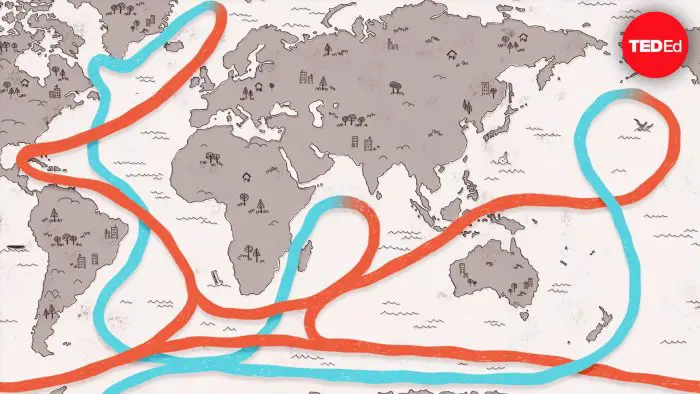Actually, the wind is not the only factor that causes ocean currents. It is true that the wind plays a role, but it is only a small one compared to some of the other variables involved.
On top of this, the factors that we are about to explain, including wind, act in different ways on different parts of the oceans and seas.
So, the main factors that alter the oceans’ currents are listed below, beginning zoomed in and then zooming out to the larger scale factors.
Shoreline obstruction
Ocean currents are not directly or greatly affected by the shorelines, but they are definitely shaped by them. When the water that makes up the ocean is moved forward thanks to the current that is affect mainly by the factors outlined below, it will eventually come to a solid mass of land.
The current is then faced with a shoreline, and it is deflected along it. The visible shoreline, that we can see about the water surface, as well as the shape of the shoreline under the water, also both affect the current’s direction.

Tides
Zooming out a little to the tides of the ocean. This is affected by the gravitational pull of the moon on the waters of earth. The moon’s gravitational field will affect the oceans and seas in a certain area at a time, causing a bulge in this area where the water is pulled slightly towards the moon.
Since the earth rotates and the moon orbits us on earth, this area of bulging water will change throughout the day and night. This is what is known as tidal forces. The sun’s gravitational pull also affects the tide and has a similar effect.
So, the water at these areas will bulge towards either the sun or the moon. In other words, it will be attracted to the sun or moon along the earth’s axis that connects it to the sun or the moon.
Obviously, thanks to us rotating and orbiting the sun, and the moon orbiting us, these axes will change all the time through a span of 24 hours. And even change season to season. These tidal forces cause the currents to move in response to them. This causes the natural high and low tide that we are accustomed to daily.
Density differences
Thinking about the oceans as a whole unit, there can be fluctuations in things like the salt levels and temperature in different parts of the ocean. This means that different areas of water mass will have different density levels.
These temperature changes come about depending on the area that the water is in relation to the equator, because the sun’s rays are stronger and warmer there.
This heat will cause the water in the area to expand and become lower in density. This dense water will fall lower and cause cooler water to rise up since it is pushed out of the way.
This is the process called convection. Hotter water drops as cooler water rises, in loops. So, the ocean currents are also affected by the density of water, the way the sun heats the surface water, and also the difference in salt levels.
The Coriolis Force
Lastly, fully zooming out now, we have the Coriolis force. Before we get into that: the earth’s rotation causes a centrifugal force that points straight upwards and the Coriolis force which will point out perpendicular to the object’s motion.
This Coriolis force means that objects in motion will travel in large circles that can be drawn on a map as if looking at the earth from space. In the northern hemisphere, these circles are clockwise, and in the southern hemisphere they are counter-clockwise.
The Coriolis force has a greater effect when great masses of water are in question, like the ocean. It is classes as an inertial force, and it relies on the rotation of the earth and the pattern of that.
It is not a fundamental force like gravity, because it relies on earth rotating in a specific reference frame. But it is a force none-the-less. And it actually causes the ocean currents along with the other factors and wind.